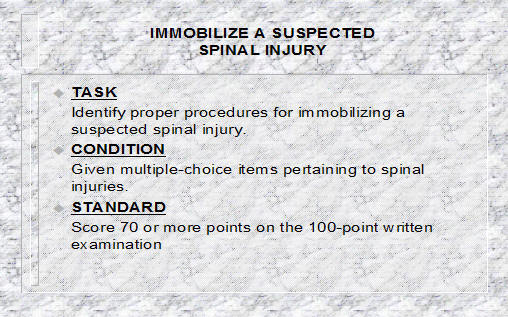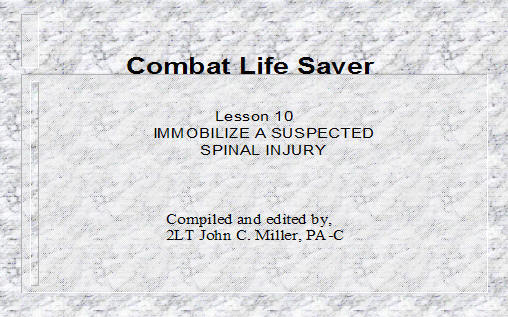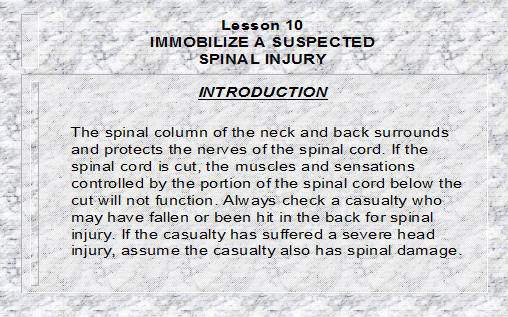IMMOBILIZE A SUSPECTED SPINAL INJURY

Click here to download the presentation.


Lesson 10
IMMOBILIZE A SUSPECTED
SPINAL INJURY
INTRODUCTION
The spinal column of the neck and back surrounds and protects the nerves of the spinal cord. If the spinal cord is cut, the muscles and sensations controlled by the portion of the spinal cord below the cut will not function. Always check a casualty who may have fallen or been hit in the back for spinal injury. If the casualty has suffered a severe head injury, assume the casualty also has spinal damage.
IMMOBILIZE A SUSPECTED
SPINAL INJURY
TASK
Identify proper procedures for immobilizing a suspected spinal injury.
CONDITION
Given multiple-choice items pertaining to spinal injuries.
STANDARD
Score 70 or more points on the 100-point written examination
IDENTIFY SIGNS AND SYMPTOMS OF A
FRACTURED SPINE
Pain or tenderness of the neck or back.
Cut or bruise on the neck or back.
Inability to move part of the body (paralysis), especially the legs.
Lack of feeling in a body part.
Touch the casualty’s arms and legs and ask if he feels your hand.
Loss of bladder and/or bowel control.
Weak respiration.
Head or back in an unusual position.
MOVE A CASUALTY WITH A SUSPECTED
SPINAL INJURY, IF NECESSARY
Do not move a casualty with a suspected spinal injury unless it is necessary to save his life, such as moving the casualty from a burning building or away from enemy fire or positioning a nonbreathing casualty to perform mouth-to-mouth resuscitation.
Use a four-man arms carry to move the casualty to a place of safety.
One soldier (usually the combat lifesaver) kneels at the casualty’s head and places his hands on both sides of the casualty’s head. This bearer keeps movement of the casualty’s head and neck to a minimum when the casualty is moved.
MOVE A CASUALTY WITH A SUSPECTED
SPINAL INJURY, IF NECESSARY
The second soldier kneels at the casualty’s chest and slips his arms under the casualty’s shoulders and waist.
The third soldier kneels next to the second soldier and slips his arms under the soldier’s hips and thighs.
The fourth soldier kneels next to the third soldier and slips his arms under the soldier’s legs (or knees) and ankles.
MOVE A CASUALTY WITH A SUSPECTED
SPINAL INJURY, IF NECESSARY
On the command, “Lift,” from the leader, all soldiers rise to their knees in unison, keeping the casualty’s head and spine in straight alignment.
If a spine board is available or one can be improvised from a door or board, the casualty should be lowered onto the spine board and secured to the spine board. The casualty should then be lifted and moved to a safe location.
On the command, “Turn,” from the leader, the soldiers gently turn the casualty toward their chests as the leader gently turns the casualty’s head to maintain spinal alignment.
MOVE A CASUALTY WITH A SUSPECTED
SPINAL INJURY, IF NECESSARY
On the command, “Rise,” from the leader, the soldiers stand in unison, maintaining alignment of the head and spine. The casualty is then carried out of danger.
When a safe location is reached, the soldiers gently lower the casualty onto a flat surface by reversing the lifting procedures and fully immobilize the casualty as described in the following learning event.
IMMOBILIZE THE CASUALTY’S SPINE
Do not attempt to straighten the casualty’s neck or back if it is in an abnormal position.
Tell the casualty to keep still and avoid unnecessary movement.
Send someone to get medical help.
If the casualty is lying on his stomach, keep him from moving until medical help arrives.
If the casualty is lying on his back, use padding to help immobilize his back, neck, and head as described below.
IMMOBILIZE THE CASUALTY’S SPINE
Roll or fold a blanket or similar padding to conform with the normal shape of the arch of the back. Carefully slide the padding under the arch of his back.
Slide a roll of cloth under the casualty’s neck to help support and immobilize his neck.
Place padded rocks, small padded logs, or filled boots on each side of the casualty’s head to keep it from moving. To use boots:
IMMOBILIZE THE CASUALTY’S SPINE
Remove the casualty’s boots. Do not remove the casualty’s boots if in a chemical environment.
Fill each boot almost to the top with sand or small rocks.
Place material (strip of clothing, sock, etc.) on top of the sand or rocks to keep the sand or rocks from falling out.
Tie the top of each boot to keep the material from coming out.
Place the boots around the casualty’s head so that the head will not turn.
IMMOBILIZE A SUSPECTED
SPINAL INJURY
CLOSING
A casualty with a suspected neck or spinal fracture should be moved by medical personnel whenever possible. If you must move the casualty to save his life, keep the movement of his back and neck to a minimum. This lesson is tested on the written examination.
Questions